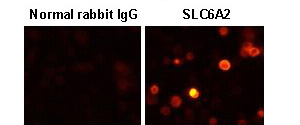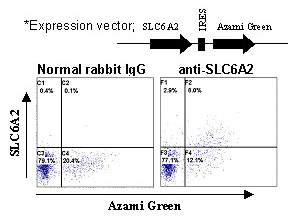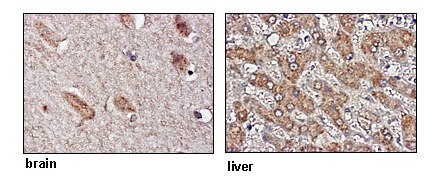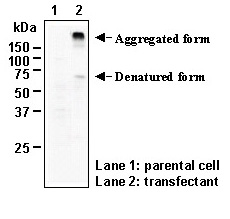Anti-SLC6A2 (NET) (Human) pAb
| Code | Size | Price |
|---|
| MBL-BMP029 | 50 ul | £340.00 |
Quantity:
Prices exclude any Taxes / VAT
Overview
Host Type: Rabbit
Antibody Isotype: IgG
Antibody Clonality: Polyclonal
Regulatory Status: RUO
Target Species: Human
Applications:
- Flow Cytometry
- Immunocytochemistry (ICC)
- Immunohistochemistry (IHC)
- Western Blot (WB)
Shipping:
4°C
Storage:
-20°C
Images
Documents
Further Information
Applications:
WB - 1:1000 (chemiluminescence detection system) FCM - 1:200 ICC - 1:200 IHC - 1:1000 (Heat treatment required for paraffin)
Background:
SLC6A2, also known as NET, is a
norepinephrine (noradrenaline) transporter, which regulates
norepinephrine homeostasis by reuptaking the
norepinephrine released into synaptic cleft in Na
+
- and Cl
-
-
dependent manner. Mutation of the SLC6A2 gene can
cause orthostatic intolerance, which is characterized by
lightheadedness, fatigue, altered mental condition, and
syncope. Drugs inhibiting the norepinephrine transporter
such as antidepressants, cocaine, and amphetamines also
lead to symptoms like orthostatic intolerance.
Formulation:
50 ul volume of PBS containing50% glycerol, pH 7.2. No preservative is contained.
Gene IDs:
Human: 6530 Mouse: 20538
Immunogen Translated:
Synthetic peptide derived from human SLC6A2
Reactivity:
This antibody can be used to stain
endogenous antigen in paraffin embedded human tissues
including the brain and liver by Immunohistochemistry.
The reactivity has been confirmed by Western blotting,
Immunocytochemistry, and intr
acellular Flow cytometry to
detect the full length of human SLC6A2 transiently
expressed in HEK 293T cells.
Shelf Life:
1 year
Source:
This antibody was affinity purified from rabbit
serum. The rabbit was immunized with a synthetic peptide
derived from human SLC6A2.
Target:
SLC6A2/NET
References
?1) Kim, C. H., et al., PNAS 103, 19164-19169 (2006)
2) Paczkowski, F. A. et al., Pharmacogenetics 12, 165-173 (2002)
3) Shannon, J. R., et al., New Eng. J. Med. 342, 541-549 (2000)
4) Pacholczyk, T., et al., Nature 350, 350-354 (1991)










